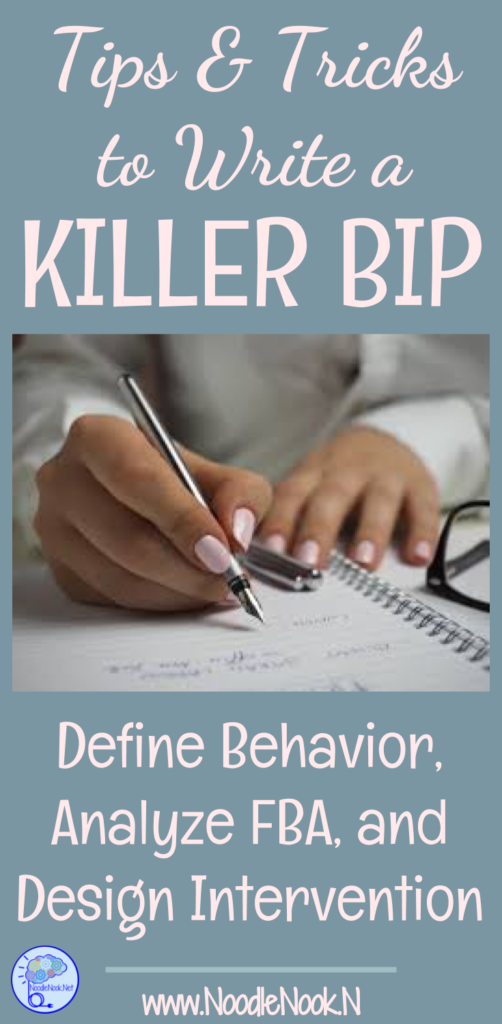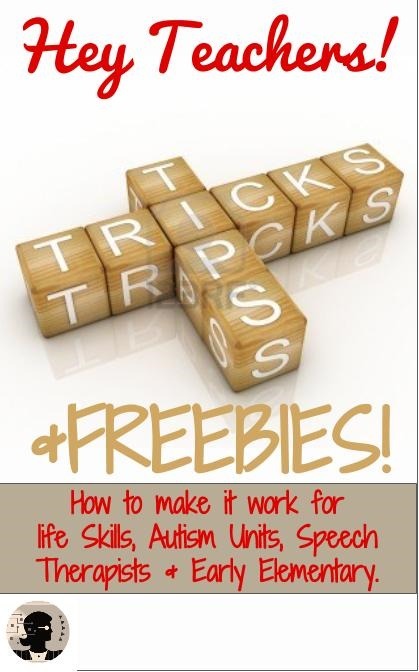How to Write a BIP
Teacher: It is terrible… Bobby is running out of class all the time!
Me: Okay, let me see the BIP.
Teacher: Oh, it’s totally not working. (Hands me the BIP.)
Me: This BIP is for verbal outbursts.
Teacher: Oh… is that why it’s not working?
Me: *sigh*
What’s the Point of a BIP: Defining the Behavior
The post last week (which you can find here) talks about why it is important to define the behavior. The teacher in the example above wrote a BIP that never touched on the target behavior, so don’t fall into that trap.
Do you have a student who has more than one behavior that needs to be changed? My guess is you do. So which one should you do first? Suggestion: target the one that is doing the most harm (or has the potential to do the most harm). For example, you have a student who is hitting himself, biting the teacher, and ripping paper. Which one would you choose?
What if the hitting of self drew blood, the biting never broke skin, and the ripping of paper was every piece of paper in the room including the teachers work and other student’s materials… now which one would you pick?
My point is the severity of the behavior is important so don’t overlook it. (By the way, I’d target the self injurious behavior first.)
How to Write a BIP: Behavior Analysis
Now that you have selected the behavior, it is so important to know the function of the behavior. (You can read more about that here.)
I can tell you right now that you cannot replace a behavior without knowing what the function is. Look more into the reason a student is doing what they do. Need a form to guide you through the analysis? Try this one here: FBA.
You will also need to think about what the student likes and items or activities you can use to entice a student as you work to change their behavior. Are you in serious need of guidance to get your juices flowing? Here is a checklist that you can use to get yourself started.
Now onto the tough stuff…
[tweetthis]Tips and tricks to write a killer BIP! Great help with free printables. #lifeskillsteacher[/tweetthis]
How to Write a BIP: Replacement Behavior
Okay- this is the seriously tough stuff. And I swear it is the one thing people overlook over and over again. The questions is simple- what do you want the student to do?
So here is the problem. As the teacher we make the same mistake over and over… we define the replacement behavior as NOT seeing the target behavior. Example:
Target behavior: Bobby hits himself.
Replacement Behavior: Bobby will refrain from hitting himself.
But this is sooo wrong. The replacement behavior is not the absence of the target behavior. It is what you want the student to do instead to get the antecedent that got them acting out in the first place.
If Bobby is hitting himself because he wants a cookie, then we need to find a replacement behavior that will get him a cookie so that he doesn’t hit himself. So how will he get the cookie? Will he use a VOD? Will he point to an image of a cookie? What he earn it as part of a work system? Going through the process of defining the replacement behavior demands you know this.
How to Write a BIP: Intervention Strategy
When it comes time to work through the intervention strategies you are going to use, there are three things you have to plan: What can we do before the behavior to prevent it? What do we need to teach the replacement behavior? And What are the consequences to deter and reinforce behavior?
That was a lot… let’s break that down.
→ Antecedent Strategy
We are targeting the things we can control before the behavior happens. What can we change to stop the behavior from happening?
What can we change about the environment? (like moving the cookies so Bobby cannot see them to avoid the trigger).
Can we add visuals to deter the behavior or remind the student of the replacement behavior?
Can we provide high levels of attention to the ‘correct’ behavior or proper use of the replacement behavior?
Can we adjust the workload to provide more opportunities to get the preferred activity or temporarily lower the rigor of the tasks to focus more energy on learning the replacement behavior?
There is a lot to think about when it comes to all the things that happen ‘before’.
→ Instructional Strategy
This is all about teaching a new coping strategy. Last week I talked to a teacher who was only using consequences to deal with a student’s behavior. No one was teaching what the student should do instead. Without a new play in his playbook, this student will only keep doing what they have always done (and continue driving their teacher crazy).
So what may that instruction look like? Check out this article on more about changing behavior (CLICK HERE) and really never forget the function of the behavior because it has to be woven into your plan. You may target teaching a communication skill to share wants and needs, a self-management skill to regulate their behavior, or a social skill to learn what appropriate behaviors are. The long and short is your student has something to learn.
→ Consequence Strategy
People hear consequences and only think negative. I had a student who I used to tell “There will always be a consequence to your choices and your behavior- you decide if it will be good or bad with what you choose to do.”
Remember the positive things. Remember how much positive words and actions play into your choices on a day to day basis- they really matter! So be sure to have positivity in your student’s day. Every day.
Equally as important as using a lot of positive reinforcement is to use preferred and non-preferred activities, but use them in a certain order. Always use preferred activities immediately AFTER non-preferred activities. It becomes a natural reason to do things and it also minimizes the amount of begging, pleading, and nagging we do.
The final thing to remember is to disrupt the chain of behavior when you see it starting. Example: Bobby sees the cookies. He starts self-talking. He starts stimming. Then he starts hitting his head. Somewhere in there we need to stop this chain of behavior. When we see the self-talk, we need to interrupt and change things. Maybe we refer to the visual that reminds Bobby of the replacement behavior… maybe we are provide Bobby with a preferred task… or maybe we use this opportunity to teach the strategy that will get Bobby what he wants. No matter what, we should not just sit back and let the chain of behavior continue.
How to Write a BIP: Putting it All Together
So now that you’ve worked through all these pieces, it’s time to pull it all together. The thing is to try some things and see what works. Don’t write a BIP (and put it in place through an IEP meeting) with only one option to work from. Have a couple of strategies outlined. Remember to take plenty of data so you can see specifically what works and what doesn’t. Adjust as needed and don’t give up. All behavior can be changed. I swear.
Now go forth and teach on!
Article Citation: [cite]






